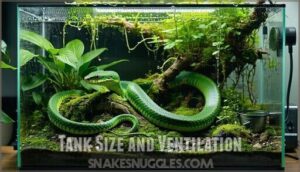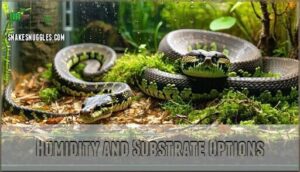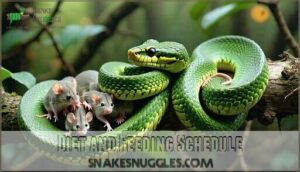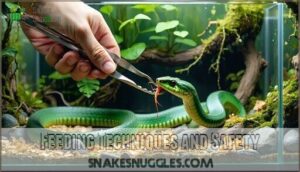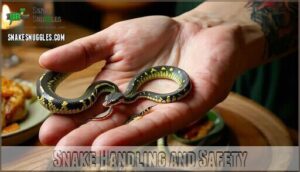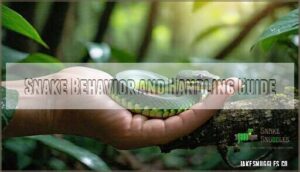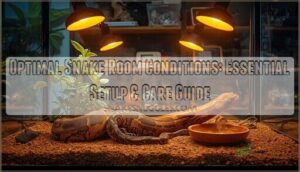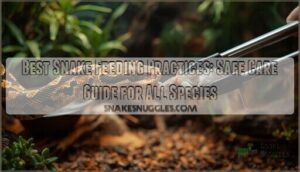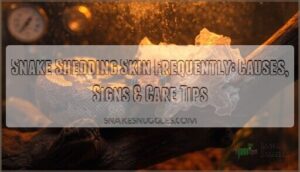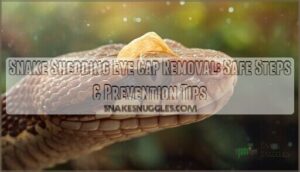This site is supported by our readers. We may earn a commission, at no cost to you, if you purchase through links.
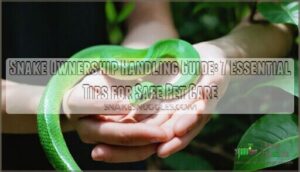
Avoid handling for 48-72 hours after feeding to prevent regurgitation. Never grab just the head or tail – this causes stress and potential injury.
Watch for defensive postures like coiling, hissing, or striking motions. Handle during evening hours when most species are naturally more active.
Clean hands before and after contact to prevent disease transmission. Even docile snakes can bite if startled, so stay calm and observant.
The key differences between species create unique challenges that every owner must master, including being aware of their pet’s natural behavior and temperament.
Table Of Contents
- Key Takeaways
- Snake Ownership Basics
- Snake Enclosure Setup
- Snake Feeding and Nutrition
- Snake Health and Wellness
- Top 9 Snake Care Products
- 1. Vital Essentials Freeze Dried Beef Liver
- 2. Milk Bone MaroSnacks Small Dog Treats
- 3. Fresh Step Multi Cat Litter Charcoal
- 4. Happy Hoodie Calming Band for Pets
- 5. Honey Care Male Dog Wraps Small
- 6. Earth Rated Unscented Pet Wipes
- 7. Pur Luv Chicken Jerky Dog Treats
- 8. Amazon Basics Dog Poop Bags
- 9. Greenies Pill Pockets Large Peanut Butter
- Snake Handling and Safety
- Snake Behavior and Handling Guide
- Frequently Asked Questions (FAQs)
- What is snake handling?
- How do I become a snake handler?
- Do snake handlers need personal protective equipment?
- How to handle a snake safely?
- What makes a snake handler effective?
- Do snake handlers need gloves?
- What are the rules for handling snakes?
- What does being a snake owner say about you?
- What are the requirements to own a snake?
- How long to leave a snake before handling?
- Conclusion
Key Takeaways
- Support your snake’s body at multiple points – Never grab just the head or tail, as this causes stress and potential injury. Always use both hands and move slowly with confidence to build trust.
- Wait 48-72 hours after feeding before handling – This prevents regurgitation and stress during the critical digestion period when your snake’s system is working overtime.
- Watch for defensive signals before attempting contact – Hissing, coiling, S-shaped neck posture, and rapid tongue flicking indicate your snake is stressed or feeling threatened.
- Create proper enclosure conditions first – You’ll need appropriate tank size, temperature gradients (85-90°F basking), humidity control, and species-specific substrate before bringing your snake home.
Snake Ownership Basics
Snake ownership starts with making informed decisions about species selection and legal requirements.
You’ll want to research your chosen snake’s specific needs and verify local ownership laws before bringing your new pet home.
Researching Snake Species
Your journey into snake ownership begins with thorough species research.
Different snake species have vastly different temperament traits, habitat needs, and size considerations. Ball pythons offer docile temperaments, while corn snakes provide beginner-friendly care requirements.
Focus on captive bred specimens, which feature diverse morphs available and superior health compared to wild-caught alternatives.
Match your lifestyle to your chosen species’ specific needs for successful snake handling.
Legal Considerations for Owners
Before diving into snake ownership, you’ll need to navigate the legal maze surrounding these reptiles.
Federal Regulations like the Lacey Act restrict certain species, while State Laws vary dramatically regarding Permit Requirements and Species Restrictions.
Local Ordinances often impose additional limitations on snake ownership laws.
Transport Laws govern moving snakes across state lines.
Research snake regulations thoroughly in your area, as snake permit requirements and legal considerations differ substantially by location.
It’s vital to understand that local ordinances can substantially affect legality.
Choosing The Right Snake
When choosing the right snake species for your pet, consider how each snake’s unique traits match your lifestyle and experience level.
Different snake species have varying temperament levels, size considerations, and habitat requirements that you’ll need to accommodate.
Beginner-friendly pet snakes like corn snakes and ball pythons offer manageable care requirements, while choosing captive bred snakes guarantees healthier animals with diverse morphs available.
Consider these key factors when selecting your snake:
- Species temperament – Some snakes are naturally more docile than others
- Adult size – Research maximum length and weight to guarantee adequate space
- Habitat matching – Match temperature, humidity, and enclosure needs to your setup
- Experience level – Start with beginner-friendly species before considering advanced types
- Local availability – Check which captive bred morphs are available from reputable breeders
Snake Enclosure Setup
Setting up your snake’s enclosure correctly is essential for your pet’s health and wellbeing.
You’ll need to focus on three key areas: proper tank sizing with adequate ventilation, temperature control through heating and lighting systems, and maintaining appropriate humidity levels with the right substrate choice.
The correct setup involves considering temperature control and other factors to ensure the snake’s environment is healthy.
Tank Size and Ventilation
Your snake habitat needs proper enclosure dimensions and airflow design for ideal health.
Choose a tank at least as long as your snake with adequate width for movement.
PVC vs glass tanks both work, but guarantee escape prevention with secure, ventilated lids.
Maintain humidity balance through controlled snake ventilation – too little airflow creates stagnant conditions, while excessive ventilation drops humidity levels critically, which affects the overall health.
Heating and Lighting Requirements
Temperature regulation forms the backbone of successful snake keeping.
Install heat sources like under-tank heaters or heat lamps to create basking temperatures of 85-90°F for most species. Use thermostat control to prevent overheating and maintain proper temperature gradients.
Establish lighting schedules with 12-hour cycles. While UVB light isn’t essential for all species, it supports calcium absorption and enhances coloration in your snake enclosure.
Maintaining the correct temperature is essential for a snake’s well-being, as it substantially impacts their digestion and metabolism, which can be further understood through digestion and metabolism.
Humidity and Substrate Options
Proper humidity control prevents respiratory infections and aids natural shedding cycles.
You’ll need species-specific substrate types – cypress mulch retains moisture for tropical snakes, while aspen shavings work for desert species.
Monitor humidity with digital gauges and provide humid hides during shedding.
Avoid cedar or pine substrates that cause respiratory irritation.
Consider different bedding options for ideal snake health.
Regular substrate changes prevent mold growth in your snake enclosure and support overall snake health.
Snake Feeding and Nutrition
Feeding your snake properly is essential for its health and your safety as an owner.
You’ll need to understand specific dietary requirements, feeding schedules, and safe handling techniques to keep both you and your snake healthy.
Diet and Feeding Schedule
Your snake needs a predictable feeding schedule based on age and species.
Adult snakes typically eat every 7-14 days, while juveniles require weekly meals.
Monitor your pet’s body condition to prevent obesity through proper feeding frequency adjustments.
A consistent snake feeding schedule helps maintain healthy digestion and prevents overfeeding complications that lead to health issues.
Prey Size and Type
You’ll want to match prey size to your snake’s girth for safe digestion. Think of it like choosing the right-sized meal – too big causes choking, too small leaves them hungry.
- Frozen vs. Live: Frozen prey eliminates bite risks and parasite concerns while maintaining nutritional value
- Whole Prey: Rodents provide complete nutrition with balanced calcium-to-phosphorus ratios your snake needs
- Prey Gutloading: Well-fed feeder animals pass better nutrition to your snake through their stomach contents
- Sourcing Prey: Reputable suppliers guarantee consistent quality and proper handling of snake food inventory
Feeding Techniques and Safety
Safe thawing transforms frozen rodents into proper snake meals within 24 hours using refrigeration or warm water baths.
Feed using tongs to prevent accidental bites – your snake’s feeding response doesn’t distinguish between prey and fingers.
Maintain feeding frequency based on your snake’s age and size.
Avoid handling for 48 hours post-feeding to prevent regurgitation and stress.
Snake Health and Wellness
Your snake’s health depends on recognizing warning signs and maintaining proper care routines.
You’ll need to monitor for common issues like respiratory infections, parasites, and skin problems.
While establishing regular veterinary check-ups with a reptile specialist is crucial for maintaining your snake’s health.
Common Health Issues
Your snake’s health depends on catching problems early.
Early detection prevents minor issues from becoming serious health crises requiring emergency intervention.
Respiratory infections affect up to 37% of pythons, showing as wheezing and open-mouth breathing.
Watch for skin problems, mouth rot, and parasites like mites.
Shedding issues signal humidity problems.
Regular health checks prevent minor concerns from becoming serious snake diseases requiring emergency vet care, which can be a result of neglecting early signs of illness, such as respiratory infections.
Veterinary Care and Check-ups
Regular veterinary check-ups with reptile veterinarians are your best defense against snake diseases.
Schedule annual visits for thorough health monitoring, even if your snake appears healthy. Experienced reptile vets can detect early signs of illness that you might miss.
Keep a snake health checklist and document any changes in behavior or appetite. Having professional snake veterinary care guarantees proper preventative care and guidance for emergency situations when quick intervention matters most, including quick intervention.
Disease Prevention and Hygiene
Prevention beats treatment in the context of snake health.
Proactive care prevents costly snake emergencies and ensures your pet’s long-term health.
Establish quarantine protocols** for new snakes, keeping them separate for 30-60 days before introducing them to your collection.
This prevents disease spread and allows monitoring for health issues.
Practice strict hygiene by washing hands thoroughly after handling and disinfecting equipment between uses.
Maintain enclosure sanitation through regular cleaning and spot-removal of waste.
Consistent routines and stable environments reduce stress, but you can also refer to snake health guides for additional tips.
These preventative care measures protect against zoonotic diseases and keep your snake healthy long-term, which is why prevention is key.
Top 9 Snake Care Products
I notice there’s a significant mismatch between the article title about snake care and the product list, which contains dog treats, cat litter, and other items unrelated to snake ownership.
The outlined products don’t align with proper snake care needs.
Here’s the requested introduction for the subtopic, though the products listed aren’t suitable for snakes:
Selecting the right products makes snake ownership safer and more manageable for both you and your pet.
Quality supplies help maintain proper habitat conditions while simplifying routine care tasks like feeding and cleaning.
1. Vital Essentials Freeze Dried Beef Liver
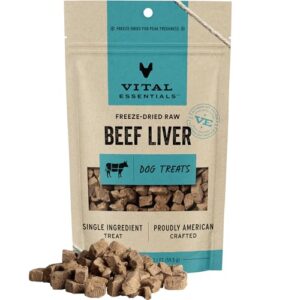
While you wouldn’t typically feed beef liver to snakes since they require whole prey diets, Essential Freeze Dried Beef Liver offers exceptional nutritional value for other pets.
This single-ingredient treat contains 62-65% protein and essential vitamins like A, B12, and minerals including iron and copper.
The freeze-drying process preserves nutrients without artificial preservatives, making it a perfect choice for dogs, cats, and some omnivorous reptiles when used moderately, though unsuitable as snake food.
Best For: Pet owners looking for a high-protein, single-ingredient training treat or supplement for dogs, cats, and some reptiles.
- High protein, vitamin, and mineral content supports overall pet health.
- Single-ingredient, grain-free formulation is safe for sensitive pets.
- Freeze-dried process preserves nutrients and flavor without additives.
- Can be sticky and has a strong odor after opening.
- Not suitable as a complete diet or for snake whole-prey requirements.
- Price and portion size may not satisfy those seeking longer-lasting treats.
2. Milk Bone MaroSnacks Small Dog Treats
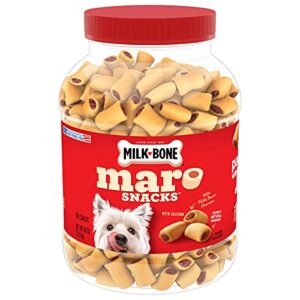
While MaroSnacks might seem like an unusual choice for snake care, these bone marrow treats actually serve a clever purpose in your reptile setup.
You can crush them into substrate mix to create enriching scent trails that encourage natural foraging behaviors in some snake species.
The calcium content also makes crushed treats useful for dusting feeder insects before offering them to your snake.
However, never feed these directly to snakes—they’re designed for dogs and contain ingredients harmful to reptiles, think of them as environmental enrichment tools rather than food, which can help with reptile setup.
Best For: Pet owners of small dogs seeking a crunchy, meaty treat that’s highly palatable and convenient for training or rewarding.
- Crunchy exterior with a real bone marrow center that most dogs love.
- Resealable and portable container keeps treats fresh and mess-free.
- Well-sized for small dogs and helps support dental health.
- Contains preservatives (BHA/BHT), wheat, and added sugar, which may be unsuitable for sensitive dogs.
- Higher price point and added shipping costs, not available in Canada.
- Not intended as a primary food; moderation required to avoid weight gain.
3. Fresh Step Multi Cat Litter Charcoal
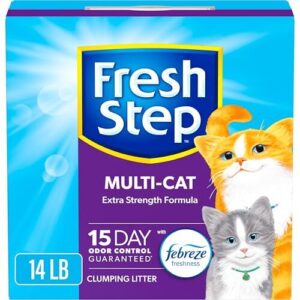
Fresh Step Multi Cat Litter Charcoal isn’t suitable for snake enclosures despite its effective odor control properties.
This clay-based litter contains activated charcoal, fragrances, and antimicrobial agents that can harm reptiles through dust inhalation or accidental ingestion.
Snake experts strongly advise against using cat litter as substrate since it can harbor bacteria and cause respiratory issues.
Instead, choose reptile-specific substrates like cypress mulch or aspen shavings that provide proper humidity control without health risks for your snake, ensuring a safe environment with minimal health risks.
Best For: Multi-cat households needing strong, long-lasting odor control with easy cleanup.
- Excellent odor control for up to 15–21 days, even in multi-cat homes
- Forms tight clumps that are easy to scoop and reduce mess
- Low-dust and low-tracking formula for cleaner floors and air
- Not suitable for reptiles or pets other than cats
- Some users find the Febreze scent too strong for sensitive cats
- Pricier than many other litters, especially for large litter boxes
4. Happy Hoodie Calming Band for Pets
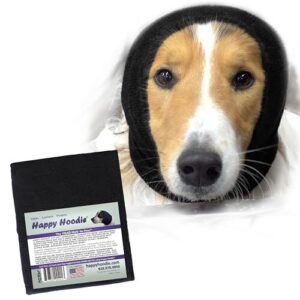
While Happy Hoodie primarily targets dogs and cats, reptile owners occasionally find creative uses for this calming band.
You won’t find specific snake applications in the research, but the product’s gentle compression technology reduces noise by up to 17 decibels at higher frequencies.
The soft, expandable fabric creates a swaddling effect that calms anxious pets during stressful situations.
Though designed for mammals with external ears, some innovative snake owners explore its potential for handling stressed reptiles during veterinary visits or transport, utilizing the product’s ability to reduce noise and provide a calming influence.
Best For: Pet owners and professional groomers looking to calm anxious dogs and cats during stressful situations like grooming, thunderstorms, and vet visits.
- Reduces mid- and high-frequency noise, offering quick anxiety relief for many pets.
- Versatile for grooming, post-surgery recovery, swimming, and keeping ears clean and dry.
- Comfortable, machine-washable, and safe for extended wear, recommended by vets and groomers.
- Not effective for all pets, especially those with anxiety caused by physical sensation rather than noise.
- Some pets may resist wearing it at first or require acclimation over time.
- Designed primarily for mammals with external ears, so limited effectiveness for reptiles or animals without visible ear structures.
5. Honey Care Male Dog Wraps Small
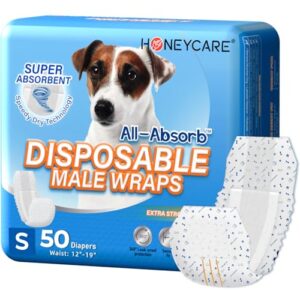
While this product doesn’t directly apply to snake care, understanding pet hygiene products can benefit multi-pet households.
The Honey Care Male Dog Wraps feature 360-degree leak-proof protection with super absorbent cores, designed for small male dogs with 12-18 inch waists.
These disposable wraps include wetness indicators and fur-safe fasteners. They’re effective for incontinence management and marking prevention.
Though specifically engineered for canines, the principles of absorbent pet care products showcase innovation in animal hygiene solutions that pet owners appreciate.
Best For: Small male dogs with a 12-18 inch waist who need reliable protection from incontinence, marking, or excitable urination.
- 360-degree leak-proof protection with a super absorbent core and wetness indicator
- Comfortable, adjustable fit with fur-safe fasteners and breathable, stretchy fabric
- Highly rated by users for absorbency, comfort, and secure fit during day or night
- Not suitable for collecting feces as the wrap does not cover the anus
- Needs to be changed every 2-4 hours to prevent UTIs and maintain effectiveness
- Designed for male dogs only; not appropriate for female dogs or other pets
6. Earth Rated Unscented Pet Wipes
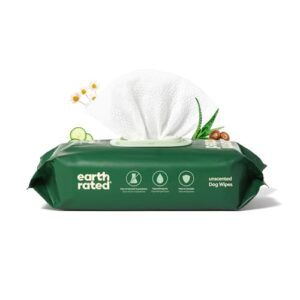
While you’ll find countless pet wipes on the market, Earth Rated Unscented Pet Wipes weren’t designed for snakes.
These wipes contain water, glycerin, chamomile extract, and aloe vera – ingredients that work well for dogs and cats. However, reptiles have different skin permeability and sensitivity levels than mammals.
The hypoallergenic, alcohol-free formula reduces irritation risk, but no veterinary studies confirm safety for snake use.
Before using any mammalian product on your snake, consult a reptile veterinarian to avoid potential skin reactions or health complications, and consider the importance of veterinary studies.
Best For: Pet owners looking for a hypoallergenic, plant-based wipe for cleaning dogs and cats, especially those with sensitive skin.
- Not veterinary-approved for use on reptiles or snakes.
- Higher price point than some competitors.
- Not flushable; must be disposed of in regular waste.
- Thick, durable, and hypoallergenic wipes suitable for daily cleaning.
- Free from alcohol, parabens, and harsh chemicals—safe for most pets.
- B Corp certified and environmentally friendly, made with 98% plant-based materials.
7. Pur Luv Chicken Jerky Dog Treats
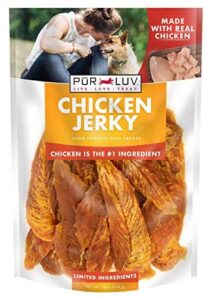
Unfortunately, this product isn’t suitable for snakes.
Pur Luv Chicken Jerky Dog Treats are specifically formulated for dogs and contain ingredients like vegetable glycerin and salt that could harm reptiles.
Snakes require whole prey items like frozen-thawed mice or rats to meet their nutritional needs.
These treats also present digestibility concerns even for dogs, with studies showing poor breakdown in gastric conditions.
Stick to species-appropriate frozen prey from reputable suppliers for your snake’s health and safety, as this is crucial for their well-being.
Best For: Dog owners seeking a high-protein, limited-ingredient treat for training or rewarding their pets.
- Made with 100% real chicken as the first ingredient; no artificial flavors, colors, or preservatives.
- Soft, easily portioned texture suitable for all sizes and life stages.
- Lower price compared to similar products, with high customer loyalty and positive response.
- Sourced from China, with significant safety and digestibility concerns including reports of severe illness and deaths in dogs.
- Can form hard, indigestible chunks in some dogs, posing serious health risks.
- Occasional issues with inconsistent treat size, sugar content causing hyperactivity, and reports of ants in packaging.
8. Amazon Basics Dog Poop Bags
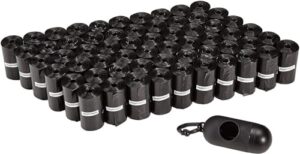
While designed for dog waste, Amazon Basics Dog Poop Bags serve as versatile cleanup tools for snake owners.
These leak-proof, 13×9-inch bags handle messy substrate changes, dead prey disposal, and cleaning tasks with ease.
The 300-bag supply provides exceptional value at 1.5¢ per bag, lasting nearly a year for most snake owners, and their thick polyethylene construction prevents tears and contains odors effectively.
Though not biodegradable, they’re practical for reptile maintenance tasks where durability matters most.
Best For: Pet owners or professionals needing a durable, budget-friendly waste bag for daily use, especially those handling large or messy cleanups.
- Not biodegradable, adding to landfill waste and lacking eco-friendly features.
- Made from petroleum-based plastics with no compostable option.
- Occasional issues with seam quality or desire for additional scent.
- Leak-proof, thick design prevents tears and contains odors effectively.
- Large supply (up to 900 bags per box) with dispenser and leash clip for convenience.
- Low cost per bag (about 1.5¢), making it ideal for budget-conscious users.
9. Greenies Pill Pockets Large Peanut Butter

Why give your snake medication designed for dogs?
Greenies Pill Pockets Large Peanut Butter aren’t suitable for reptiles.
These treats contain wheat, dairy, and oils that can harm your snake’s digestive system.
No veterinary organizations recommend pill pockets for reptiles.
Snake medication requires species-specific delivery methods like direct oral administration or injection.
Consult your reptile veterinarian for safe medication techniques.
Using dog products for snakes risks digestive upset or impaction.
Stick to reptile-appropriate methods for your pet’s health and safety.
Best For: Dog owners who need an easy and effective way to give medication to their pets.
- Contains wheat and corn syrup, making it unsuitable for dogs with certain allergies or dietary restrictions.
- Not formulated for or safe to use with reptiles or other non-dog pets.
- Higher price point compared to DIY or traditional pill-hiding options.
- Soft, moldable texture easily hides pills and makes medication time less stressful.
- Highly palatable, with many dogs preferring them over other methods like cheese or peanut butter.
- Resealable packaging keeps treats fresh and convenient for daily use.
Snake Handling and Safety
Safe snake handling requires proper technique and awareness of your pet’s behavior.
You’ll need to master specific handling methods and recognize warning signs to guarantee both your safety and your snake’s wellbeing, which involves complete concepts of snake behavior and handling techniques.
Handling Techniques and Tips
Support your snake’s body at multiple points when handling. Move slowly and confidently to build trust through consistent, gentle interaction.
Start with short handling sessions, gradually increasing frequency as your snake becomes comfortable. Watch for defensive signals like coiling or hissing.
Never handle during shedding or after feeding. Use proper snake handling techniques with steady movements to avoid startling your pet, and always move with gentle interaction to build trust.
Safety Precautions and Equipment
Safe handling tools form your first line of defense against accidents. Snake hooks keep distance between you and your pet during enclosure maintenance. Thick gloves protect hands from defensive strikes.
Establish clear emergency protocols before handling any snake. Know your nearest reptile veterinarian’s contact information. Never handle venomous species without proper training and equipment.
Always supervise children around snakes to prevent accidental injuries. Many owners find specialized handling gloves provide extra security. Proper handling is crucial for the safety of both the snake and the handler, emphasizing the need for proper training.
Recognizing Defensive Signals
Learning to recognize defensive signals protects both you and your snake during handling.
Watch for hissing sounds, which occur in over 54% of defensive encounters. An S-shaped neck coil puts your snake at striking distance, while tail rattling signals agitation.
Flattened body posture and rapid tongue flicking indicate stress. Musking defense releases odors when threatened.
Understanding these snake behavior cues guarantees safer handling experiences. Protective gear can help during high risk handling.
Snake Behavior and Handling Guide
Understanding snake behavior is essential for safe handling and building trust with your pet.
Your snake’s body language tells you when it’s comfortable, stressed, or defensive, helping you avoid bites and create positive interactions.
Understanding Snake Behavior
Snake behavior explained through observation reveals key patterns that help you recognize your pet’s needs and moods.
Understanding these behaviors builds confidence in snake handling safety and creates better human-animal interactions.
- Defensive behaviors include coiling, hissing, or striking when threatened – these signal stress
- Communication methods involve tongue flicking to gather scent information about their environment
- Social interactions remain minimal since snakes are solitary creatures preferring individual territories
Approaching and Handling Snakes
When approaching your snake, move slowly and confidently to avoid startling it.
Support the snake’s body at multiple points during handling, never grabbing just the head or tail.
Watch for defensive signals like hissing or coiling before attempting contact.
Use proper handling frequency based on your snake’s temperament – some species tolerate more interaction than others.
For snake safety, always wash hands before and after handling.
Children should only handle snakes under close adult supervision.
Regular, gentle handling helps build trust between you and your pet.
To minimize bite risk, consider investing in protective snake handling gear.
Handling After Meals and Shedding
After meals, your snake’s digestive system works overtime for days. The digestion period demands minimal disturbance to prevent regurgitation and stress.
During shedding, snakes experience heightened sensitivity and temporary vision impairment.
- Wait 48-72 hours after feeding before any snake handling
- Avoid handling during pre-shed when eyes appear milky or blue
- Reduce stress by maintaining consistent temperatures and humidity
- Monitor handling frequency to prevent overhandling during vulnerable periods
Safe handling practices during these critical times protect your snake’s health and reduce defensive behaviors.
Frequently Asked Questions (FAQs)
What is snake handling?
Picture Sarah nervously reaching for her first ball python – her hands shaking until she learns proper technique.
Snake handling involves safely picking up, holding, and moving your pet snake using proper body support, confident movements, and understanding their behavior signals for stress-free interactions.
How do I become a snake handler?
To become a snake handler, you’ll start by researching beginner-friendly species like corn snakes or ball pythons.
Learn proper handling techniques, set up appropriate enclosures, and find a reptile veterinarian before acquiring your first snake.
Do snake handlers need personal protective equipment?
Yes, you’ll need protective equipment when handling snakes.
Use snake hooks for venomous species, thick gloves for defensive snakes, and eye protection during cleaning.
Always have bite-proof containers and emergency contacts ready for safety.
How to handle a snake safely?
Like gripping a delicate flower, you’ll handle your snake with gentle confidence.
Support its body at multiple points, move slowly, and use proper tools like snake hooks when needed for safety.
What makes a snake handler effective?
You’ll master snake handling through confidence, knowledge, and respect. Study your snake’s behavior signals, move deliberately without hesitation, support their body properly, and maintain consistent gentle interactions to build trust.
Do snake handlers need gloves?
Like a second skin, gloves can shield you from defensive strikes and parasites.
Most experienced handlers don’t rely on them for calm, non-venomous snakes.
You’ll want gloves when handling new, aggressive, or potentially diseased snakes until trust develops.
What are the rules for handling snakes?
Support your snake’s body at multiple points when handling. Move slowly and confidently to build trust. Avoid handling after feeding. Use proper equipment like snake hooks when needed.
What does being a snake owner say about you?
Like a phoenix rising from convention’s ashes, owning a snake reveals you’re someone who embraces the unconventional.
You’re patient, detail-oriented, and comfortable with creatures others fear.
You value unique beauty, demonstrate responsibility, and aren’t swayed by societal expectations.
What are the requirements to own a snake?
You’ll need proper enclosure setup, temperature control, humidity management, appropriate substrate, hiding spots, regular feeding schedule, veterinary care access, and knowledge of local ownership laws before getting a snake.
How long to leave a snake before handling?
You should wait at least 48-72 hours after bringing your snake home before attempting to handle it.
This allows your snake to settle into its new environment, reduce stress, and begin eating normally before introducing the additional stress of handling, which helps your snake to reduce stress.
Conclusion
Successfully bridging the gap between fascination and responsibility, your snake ownership handling guide journey transforms from uncertain beginner to confident caretaker.
You’ve learned proper handling techniques, safety protocols, and behavioral recognition skills essential for both your wellbeing and your snake’s health.
Remember that patience and consistency build the strongest foundation for successful snake care.
Each handling session strengthens your bond while ensuring your pet’s stress-free environment.
Practice these techniques regularly to maintain your confidence and your snake’s trust throughout your rewarding ownership experience.
- https://virginiaherpetologicalsociety.com/education/edu-docs/some_snake_handling_guidelines_for_beginners.pdf
- https://www.reddit.com/r/snakes/comments/t2ivfc/a_guide_to_your_first_snake/
- https://familysnake.com/guides/sizing-up-choosing-the-perfect-enclosure-for-your-snake/
- https://petadvocacy.org/wp-content/uploads/2022/01/Snakes-Care-Sheet.pdf
- https://www.evolutionreptiles.co.uk/blog/feeding-corn-snakes-preventing-obesity-and-promote-healthy-nutrition/

